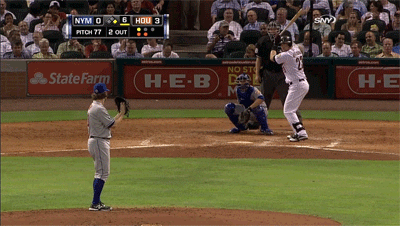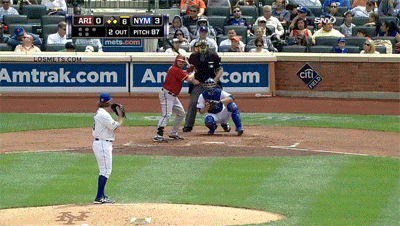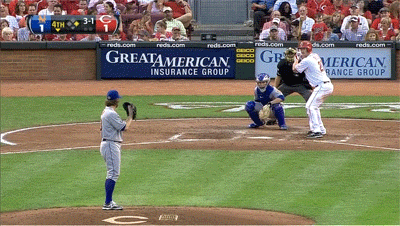R.A. Dickey, who makes his final start of the season this evening in Miami, doesn't lack for résumé bullet points to sway Cy Young voters. Unsatisfied to elevate his career at an age when most pitchers are heading out to pasture, Dickey has also elevated the standard to which knuckleballers can aspire. He leads the National League in strikeouts, innings pitched, complete games and shutouts. He has an ungodly 4.1 K/BB ratio. He’s been one of the few bright spots on a Mets team that might be in last place without him. And fine, I’ll say it: Dickey is the first Met to win 20 games since Frank Viola in 1990. He even offers enough charming human interest angles to fill several episodes of This American Life.
Allow me, then, to toss a molehill on top of that mountain of accomplishment: R.A. Dickey is doing a historically great job of holding runners on base. With agility, poise, and a deep understanding of the fundamentals—as well as some out-and-out flaunting of the rulebook, which we’ll examine later—Dickey has overcome the highest possible degree of difficulty to not only hold his own against the running game, but become one of the very best in baseball at shutting it down. In 2012, only three qualified starters in all of baseball have allowed fewer stolen base attempts per stolen base opportunity than Dickey (defining “stolen base opportunity” as a man on first or second with the next base open). The average qualified starter has allowed 5.81 stolen base attempts per 100 opportunities this season. Dickey has allowed 1.85.
So what makes Dickey’s degree of difficulty so much higher than everyone else’s? For starters, check that first paragraph again: Dickey is really, really good. During the Mets’ loss in San Diego on August 3rd, a couple of pitches before Dickey picked Everth Cabrera off first, Padres play-by-play man Dick Enberg explained: “It figures if Cabrera guesses right, he’s going to try to steal second base, give [Chris] Denorfia a chance to bring him in. San Diego will not get many chances to score on Dickey.”
Of course, great pitchers don’t give up many baserunners in the first place, but it follows that the better the pitcher, the more attempts per opportunity, as teams try to make the most of the few baserunners they get. But there are plenty of great pitchers every year—not so many on Dickey’s level, but close. What’s the true differentiator that puts Dickey behind the eightball?
Well, if a great pitcher makes opposing teams aggressive on the bases, imagine how aggressive they’ll be if the great pitcher throws a pitch that averages 78 miles per hour—fast for a knuckler, but still slow—and could go to the backstop at any time. And he throws it, say, 79 percent of the time, to a catcher in Josh Thole who looks like Channing Tatum and probably throws like him, too. Potential basestealers would be inclined to be aggressive against any pitcher of Dickey’s caliber, but the particulars of Dickey’s pitching approach would seem to make every baserunner a true threat to go. And yet only six have tried, three of whom succeeded.
Before we get to the reasons why only six runners have been brave enough to go, I’d be remiss not to mention one thing aiding Dickey in holding runners. As Jim Bouton wrote in Ball Four (in the midst of giving up 16 steals against seven caught stealings in 122 2/3 IP in 1969, after never having allowed more than seven steals in a season before he picked up the knuckleball), throwing a knuckleball “is like playing catch with your grandmother.” If you have a grandmother handy, toss her a quick four-seamer—notice how little body torque you generated so as not to eviscerate any of her vital organs? Dickey doesn’t have to worry about gearing himself up to blow one by a hitter, so he can afford to be quick to home plate to dissuade potential running threats. With men on base, Dickey almost exclusively uses the slide-step, which takes pinpoint body control not shared by all knuckleballers; Tim Wakefield, who allowed an amazing 448 career stolen bases, used the slide-step relatively infrequently, and was on record saying that he felt more comfortable not using it.
That said, Dickey is a master of the fundamentals common to all right-handed pitchers looking to curb the running game. All righties are taught to vary the time they stay set before delivering from the stretch, in order to throw a runner’s timing off. A pitcher will practice coming set and holding there for counts of, say, one, three, and five seconds before starting his motion. One of the more effective and underutilized parts of that strategy is simply holding the ball without pitching or picking off; especially after a series of quick releases, holding set indefinitely can weaken the knees of a tense would-be basestealer.
On April 30th against the Astros, Dickey showed just how effective varying his looks could be. Down 3-0 in the bottom of the sixth, Dickey faced Chris Johnson with Brian Bogusevic on first. Over a five-pitch sequence (four knucklers and one fastball), Dickey exclusively used a fairly quick release. By pitch six, Bogusevic had his read; he was going to time the start of Dickey’s motion and take off. But Dickey had outfoxed him, and pitch six was never delivered:

Dickey owes his other four pickoffs in 2012 to some underhanded trickery better known around baseball as veteran guile. In other words, Dickey is balking all over the place. That he’s been called for just two balks over the past two seasons (both times with Domonic Brown batting) is a testament to how well he hides it, but he is unfairly deceiving runners. Do I begrudge him for it? On the contrary—I think he’s an exemplar every pitcher should learn from. Let’s see exactly how he does it.
The first trick is built into every single pitch Dickey throws from the stretch, and it concerns the way in which he comes set. Dickey’s motion from when he gets the sign to when he comes set is fluid by design; he brings his hands to his belt, then up through his torso to neck level, and finally about a foot away from his body before he finally stops. It’s extremely deliberate and leaves the batter and baserunner (and, apparently, umpires) unable to tell exactly when he has come set. Here’s how Enberg describes it: “He almost double-sets; he comes to one set, but then he pushes his arms out as if he’s about to pitch, and that’s when he throws to first base.”
If you’ve never heard of the old double-set technique, that’s because it’s illegal and should be called a balk. Umpires allow Dickey to do his thing because, by rule, a pitcher can come set any way he pleases so long as he is consistent. (If you’re unclear, a pitcher must come to a stop to go to the plate, but not to attempt a pickoff.) But Dickey’s inconsistencies here are so slight as to be imperceptible; sometimes he doesn’t even push his arms out before coming to a stop, enabling him to quick-pitch a batter and catch a would-be basestealer rooted to the ground, thinking he hadn’t even come set yet.
The second trick is more flagrant (and on a personal note, it’s one I’ve been complaining about since high school). I’ve heard a few names for it, but we’ll call it the “knee pop.” The knee pop is a very subtle spasm of the front (left) leg before the pitcher steps off the rubber with his back (right) leg to attempt a pickoff. When a runner is given the steal sign, he’s looking for the first movement of that front leg as an indicator that the pitcher is going home; when that leg moves and the pitcher somehow still throws to first, that’s bad news for the baserunner. Dickey has turned the knee pop into an art form, using it to pick off four baserunners this year. See if you detect any foul play as he nails Gerardo Parra on May 6th:

Or how about his pickoff of Cabrera, after Enberg tried to warn him:

Still confused? It’s tough for us to see, but it’s also tough for the umpires to see, and they’re standing 65 feet away and getting paid to pick up on things like that. If you can’t make it out, fear not: this video should make things clear. Made by umpiring site UmpHub, it helpfully exaggerates the motion to drive home the nature of the deception. You can see how popping the knee and stepping off in a fluid motion could nab an aggressive runner.
Now that you know the rule, watch Jay Bruce fall for it on August 15th. “He’s not going anywhere. I mean, he’s not stealing on this pitch,” says Reds announcer Chris Welsh. Then why did Bruce take a step towards second? Well, here’s why:

Unfortunately, the TV cameras haven’t given us great angles of Dickey’s move at its best. We do have one, however, of his move at its worst: on September 17th, he tried his sorcery on Carlos Ruiz, who was lucky to have Balkin’ Bob Davidson there to do what he does best:

Davidson rightly called a balk. Dickey argued immediately and had a lengthy conversation with Davidson after finishing the inning. You can’t really blame the guy for complaining about a move that, by now, he’s grown accustomed to getting away with. In fact, after the season he’s had, Dickey must be accustomed to just about everything going his way. He’s the best in the world at what he does—it took years of practice to make the knuckler look that easy. Now he gets to go out to the mound, play catch with his grandmother, and file his nails while his fellow pitchers are taking ice baths—and he might walk away with the Cy Young award for his efforts. When an athlete has worked hard to be as good as Dickey has been at preventing runners from both reaching base and stealing bases, maybe he’s entitled to get away with murder. Or at least a few balks.
Thanks to Ben Lindbergh and Colin Wyers for research assistance.
Thank you for reading
This is a free article. If you enjoyed it, consider subscribing to Baseball Prospectus. Subscriptions support ongoing public baseball research and analysis in an increasingly proprietary environment.
Subscribe now
http://oxforddictionaries.com/definition/american_english/flaunt
Do they have seminars on baseball?
This should be in a seminar on baseball.
To each his/her own, I guess.